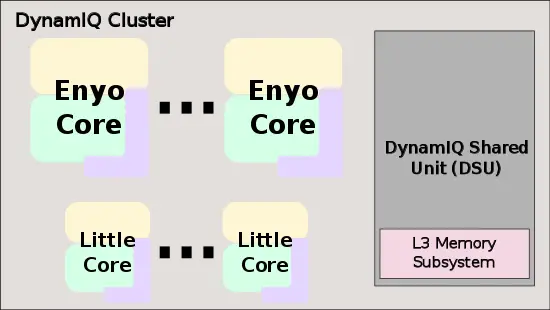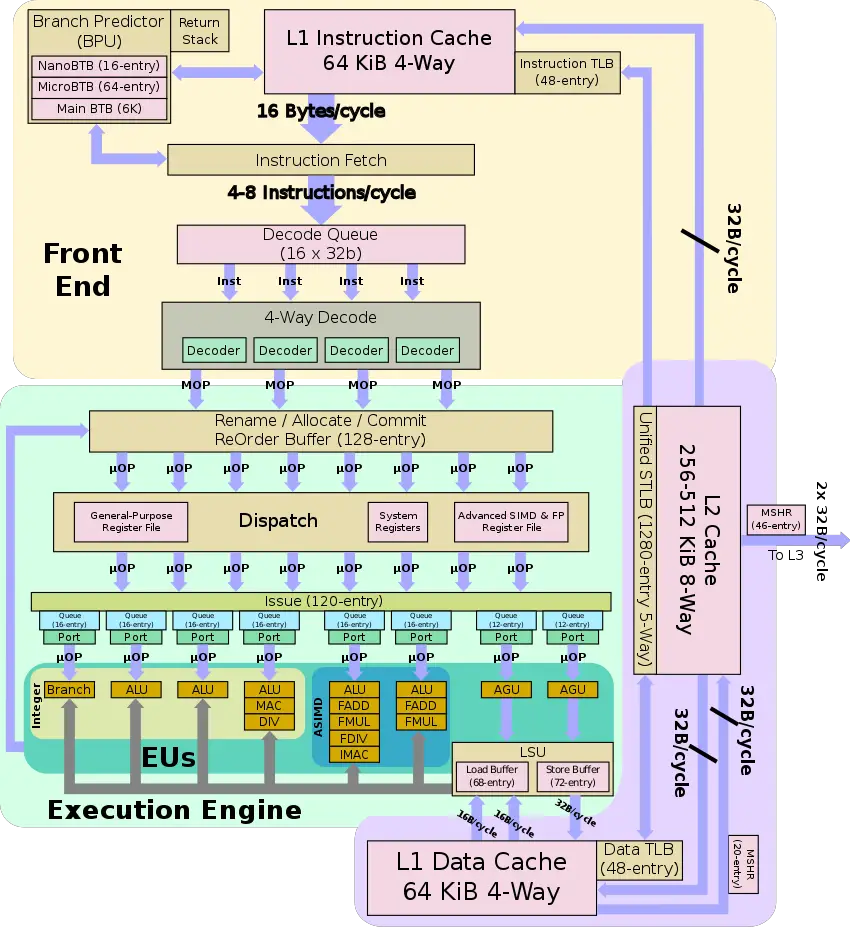(→Core) |
|||
| Line 55: | Line 55: | ||
== Core == | == Core == | ||
| − | {{ | + | The Cortex-A76 succeeds the {{\\|Cortex-A75}}. It is designed to take advantage of the [[7 nm]] node in order to deliver up to 35% higher performance and up to 40% lower power (compared ot the A75 on the [[10 nm]] node). It's worth noting that the A76 brings higher performance at a slight hit to area by going wider. |
=== Overview === | === Overview === | ||
{{empty section}} | {{empty section}} | ||
Revision as of 00:34, 28 December 2018
| Edit Values | |
| Cortex-A76 µarch | |
| General Info | |
| Arch Type | CPU |
| Designer | ARM Holdings |
| Manufacturer | TSMC |
| Introduction | May 31, 2018 |
| Process | 7 nm |
| Core Configs | 1, 2, 4 |
| Pipeline | |
| OoOE | Yes |
| Speculative | Yes |
| Reg Renaming | Yes |
| Stages | 13 |
| Decode | 4-way |
| Instructions | |
| ISA | ARMv8.2 |
| Extensions | FPU, NEON |
| Cache | |
| L1I Cache | 64 KiB/core 4-way set associative |
| L1D Cache | 64 KiB/core 4-way set associative |
| L2 Cache | 256-512 KiB/core 8-way set associative |
| L3 Cache | 0-4 MiB/Cluster |
| Succession | |
| Contemporary | |
| Ares | |
Cortex-A76 (codename Enyo) is the successor to the Cortex-A75, a low-power high-performance ARM microarchitecture designed by ARM Holdings for the mobile market. This microarchitecture is designed as a synthesizable IP core and is sold to other semiconductor companies to be implemented in their own chips. The Cortex-A76, which implemented the ARMv8.2 ISA, is the a performant core which is often combined with a number of lower power cores (e.g. Cortex-A55) in a DynamIQ big.LITTLE configuration to achieve better energy/performance.
Contents
Process Technology
Though the Cortex-A76 may be fabricated on various different process nodes, it has been primarily designed for the 12 nm, 7 nm, and 5 nm process nodes.
Architecture
Key changes from Cortex-A75
Block Diagram
Typical SoC
Individual Core
Memory Hierarchy
| This section is empty; you can help add the missing info by editing this page. |
Overview
The Cortex-A76 is a high-performance synthesizable core designed by Arm as the successor to the Cortex-A75. It is delievered as Register Transfer Level (RTL) description in Verilog and is designed. This core supports the ARMv8.2 extension as well as a number of other partial extensions. The A76 is a 4-way superscalar out-of-order processor with a private level 1 and level 2 caches. It is designed to be implemented inside the DynamIQ Shared Unit (DSU) cluster along with other cores (e.g., with little cores such as the Cortex-A55)
Core
The Cortex-A76 succeeds the Cortex-A75. It is designed to take advantage of the 7 nm node in order to deliver up to 35% higher performance and up to 40% lower power (compared ot the A75 on the 10 nm node). It's worth noting that the A76 brings higher performance at a slight hit to area by going wider.
Overview
| This section is empty; you can help add the missing info by editing this page. |
Pipeline
| This section is empty; you can help add the missing info by editing this page. |
Bibliography
- Arm Tech Day, 2018
| codename | Cortex-A76 + |
| core count | 1 +, 2 + and 4 + |
| designer | ARM Holdings + |
| first launched | May 31, 2018 + |
| full page name | arm holdings/microarchitectures/cortex-a76 + |
| instance of | microarchitecture + |
| instruction set architecture | ARMv8.2 + |
| manufacturer | TSMC + |
| microarchitecture type | CPU + |
| name | Cortex-A76 + |
| pipeline stages | 13 + |
| process | 7 nm (0.007 μm, 7.0e-6 mm) + |

